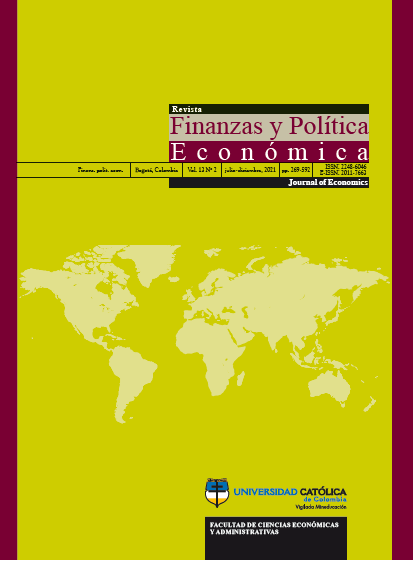
This work is licensed under a Creative Commons Attribution-NonCommercial-ShareAlike 4.0 International License.
This journal is licensed by a Creative Commons Attribution License (CC BY-NC-SA 4.0) Attribution-Non Commercial 4.0 International. For the CC licenses, the principle isthe creative freedom. This system complements the copyright without opposing it, conscious of its importance in our culture. The content of the articles is the responsibility of each author, and does not compromise in any way, to the journal or the university. It allows the transmission and reproduction of titles, abstracts and full content, with academic, scientific, cultural ends, provided acknowledgment of the respective source. This work cannot be used for commercial purposes.
They journal does not charge authors for submission or publication.
Abstract
Currently there is no agreed method to estimate the Risk Premium accurately, therefore, different authors arrive at significantly different results when calculating the risk premium for a given country or industry. This work estimates the risk premium of the Chilean stock market (PRM) for the period 1993-2020 using different estimation methodologies (Differential Returns, Implicit Return in Current Stock Prices). The results indicate, depending on the methodology used, a Premium for Risk that ranges between 1,91% and 10,28%, which shows the existence of a positive premium for assuming risk in Chile that ranges around 5,3%.

References
Abdul, W., Phuong, T., & Zurbruega, R. (2021). The non-pecuniary determinants of sovereign and bank rating changes. Finance Research Letters, 41, doi.org/10.1016/j. frl.2020.101814.
Arrow, K. (1964). The role of secutirties in the optimal allocation of risk bearing. Review of Economic Studies, 31, 91-96. https://doi.org/10.2307/2296188
Baker, S., Bloom, N., & Davis, S. (2015). Measuring Economic Policy Uncertainty. The Quarterly Journal of Economics, 131(4), 1593-1636. https://doi.org/10.1093/qje/qjw024
Baltussen, G., Martens, M., & Penninga, O. (2021). Predicting Bond Returns: 70 Years of International Evidence. Financial Analysts Journal, https://doi.org/10.2139/ ssrn.3631109
Damodaran, A. (2008). Equity Risk Premiums. Obtenido de http://citeseerx.ist.psu.edu/viewdoc/download?doi=10.1.1.198.4830&rep=rep1&type=pdf
Damodaran. (2019). Implied. Obtenido de http://people.stern.nyu.edu/adamodar/podcasts/valspr15/valsession5.pdf:
Damodaran. (s.f.). Implied Equity Premiums. Obtenido: http://pages.stern.nyu.edu/~adamodar/: http://pages.stern.nyu.edu/~adamodar/
Dos Santos, M., Klotzle, M., & Pinto, A. (2021). The impact of political risk on the currencies of emerging markets. Research in International Business and Finance, 1-11. https://doi.org/10.1016/j.ribaf.2020.101375
Durbin, E., & Ng, D. (2005). The sovereign ceiling and emerging market corporate bond spreads. Journal of International Money and Finance, 631-649. https://doi.org/10.1016/j.jimonfin.2005.03.005
Edwards, S. (1984). LDC foreign borrowing and default risk: an empirical investigation 1976-1980. National Bureau of Economic Research, 726-734.
El-Shagi, M., & Von Schweinitz, G. (2021). Fiscal policy and fiscal fragility: Empirical evidence from the OECD. Journal of International MOney and Finance, 115. https://doi.org/10.1016/j.jimonfin.2020.102292
Francis, J., & Kim, D. (2013). Modern Portfolio Theory. Foundations, Analysis, and New Developments. United States of America. John Wiley & Sons, Inc, 126-130.
Fuenzalida, D., Mongrut, S., & Nash, M. (2005). Riesgo Pais y Riesgo Soberano: Concepto y Medición. Revista Mexicana de Economía y Finanzas, 4 (4), 347-367. https://doi.org/10.21919/remef.v4i4.210
Hirshleifer, J., & Riley, J. (1992). The Analytics of Uncertainty and Information. United Kingdom. Cambridge University Press, 69-73. https://doi.org/10.1017/CBO9781139167635
Kahneman, D., & Tversky, A. (2013). Prospect Theory: An Analysis of Decision Under Risk. Handbook of the Fundamentals of Financial Decision Making, 99-127. https://doi.org/10.1142/9789814417358_0006
Kashyap, R. (2018). solving the Equity Risk Premium Puzzle and Inching Toward a Theory of Everything. The Journal of Private Equity, 21, 45-63. https://doi.org/10.3905/jpe.2018.21.2.045
Lira, F., & Sotz, C. (2011). Estimación del Premio por Riesgo en Chile. Documento de Trabajo Nº617 del Banco Central de Chile.
Lucas, R., & JR. (1978). Asset Prices in an Exchange Economy. Econometrica 46, 1429-1445. https://doi.org/10.2307/1913837
Maquieira, C. (2008). Finanzas Corporativas, Teória y Práctica. Santiago-Chile: Ed. Andrés Bello.
Mehra, R., Prescott, & Edward. (1985). The Equity premium: A puzzle. Journal of Monetary Economics, 15 (2), 145-161. https://doi.org/10.1016/0304-3932(85)90061-3
Mullins, D. (1982). Does the Capital Asset Pricing Model Work? Obtenido de Harvard Business Review: https://hbr.org/1982/01/does-the-capital-asset-pricing-model-work
Neumann, J., & Morgenstern, O. (1953). Theory of Games and Economic Behavior. Princeton, New Jersey: Princeton University Press.
Rietz, T. (1988). The equity risk premium a solution. Journal of Monetary Economics, 22(11), 117-131. https://doi.org/10.1016/0304-3932(88)90172-9
Ross, S., & Westerfield, R. (2012). Finanzas Corporativas. USA: McGraw-HIll Companies.
Yacine, A. (2015). Testing Continuos-Time Models of the Spot Interest Rate. The Review of Financial Studies, 9 (2), 385-426. https://doi.org/10.1093/rfs/9.2.385
Zhengyang, J. (2021). Fiscal Cyclicality and Currency Risk Premia. The Review of Financial Studies.





























